Noblis ransomware – a Phytin-written cryptomalware that demands 1 BTC for file redemption
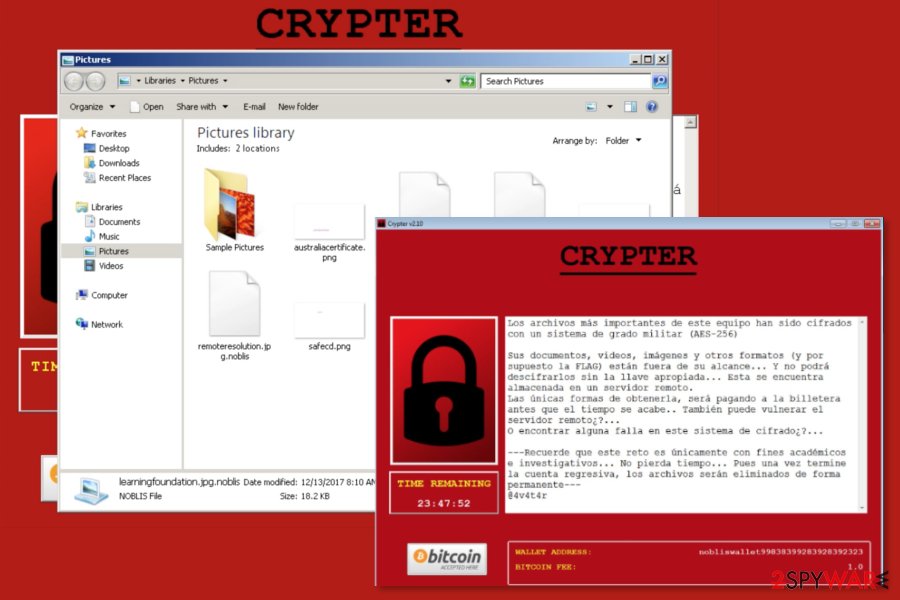
Noblis is crypto-malware that aims at Spanish[1] computer users and is written in Phyton. The file-encrypting virus uses AES-256 cipher[2] to encode files and make them inaccessible by adding .noblis, .anyrun, or, most recently, .sorryforthis, file extension. Following the encryption, it opens program Window Crypter v2.10 with data recovery instructions.
Some ransomware viruses are not designed by cybercriminals, and Noblis ransomware is one of them. Instead, the virus was written for educational purposes only, but most likely leaked by malicious actors – a similar situation happened to HiddenTear malware. Thus, the Noblis virus is created with the help of ransomware generator software.
After Noblis ransomware initial release in December 2017, it went doormat and did not show much activity. Later, Cyclone ransomware was developed based on this malware. Most recently, in late October 2019, the newest variant of the virus was released – the ransom note is written in English, and attackers now ask for 0.08134 BTC payment for the decryptor.
| Name | Noblis |
| Type | Ransomware, cryptovirus |
| Initial release | December 2017 |
| Written in | Phyton programming language |
| Cipher | Malware uses AES-256 to encrypt data on the host system |
| Distribution means | Ransomware is known to be spread with the help of obfuscated spam email attachments, although other means might be used as well |
| Targets | Initially, malware targeted Spanish users but the most recent variant drops ransom note in English, meaning that the attackers chanced the distribution scope and aim to infect users worldwide |
| Versions | .noblis, .anyrun and .sorryforthis |
| Newest variant | .sorryforthis variant of malware was spotted in the wild at the end of October 2019 and asks users for 0.08134 BTC for file decryption software |
| Related | Cyclone ransomware derived from this malware |
| Termination | Use anti-malware software to locate the payload and remove all the components |
| File decryption | Only possible via backups. In some cases, third-party recovery software might be effective – check the methods described below |
| Recovery | After malware is deleted from Windows, it might start misbehave due to system file damage. To fix crashes, slowdowns, and similar aftereffects of ransomware, use Reimage |
According to the latest research data, malware is in in-dev mode. However, obfuscated payload called noblis.exe might be soon spread via malicious spam emails or using other ransomware distribution methods.
Once inside, Noblis ransomware makes necessary system changes before starting the encryption:
- Executes the dropper from Temp folder and unpacks associated files
- Establishes connection with a remote server
- Deletes Shadow Volume Copies to prevent file recovery
- Alters the registry and other vital Windows components to gain persistence, etc.
Noblis ransomware then starts file encryption with a strong cipher and uses encrypted_files.txt during the process – the file is placed into the %AppData% folder. When the virus finishes its destructive task, it opens a program Window with timer and Spanish recovery instructions:
Crypter
YOUR FILES HAVE to the BEEN The ENCRYPTED!
Archivos más importantes los de este equipo han edition sido cifrados con un sistema de Grado militar (the AES-256)
Sus Documentos, the videos, imágenes y otros formatos (y por supuesto la the FLAG) están fuera de alcance the su … the Y the no podrá descifrarlos sin llave apropiada … la Esta se Encuentra almacenada en un Servidor remoto.
Únicas Formas de las obtenerla, será la pagando a billetera antes que of el tiempo se .. acabe También puede vulnerar of el Servidor remoto¿? …
About encontrar alguna falla en este sistema de cifrado¿? …
— Recuerde que este reto es únicamente con fines an e … investigativos académicos No pierda tiempo … Pues una vez termine la cuenta regresiva, the los archivos serán eliminados de forma permanente —
@ 4v4t4r
WALLET the ADDRESS: nobliswallet99838399283928392323
Bitcoin of FEE: 1.0
The interesting fact is that the final sentences of ransom note tell that malware was created for academic and research purposes. However, it seems that someone wants to learn to program by harming others. According to the ransom note, Noblis virus is designed to delete files once the timer goes to zero (after 24 hours).
However, authors of Noblis ransomware offer not to waste time and obtain decryption software immediately. Victims have to transfer 1 Bitcoin to the provided wallet address. The research has shown that criminals provided a wrong address. Thus, even if you decide to sponsor criminals with such a huge amount of dollars, you won’t be able to do it.
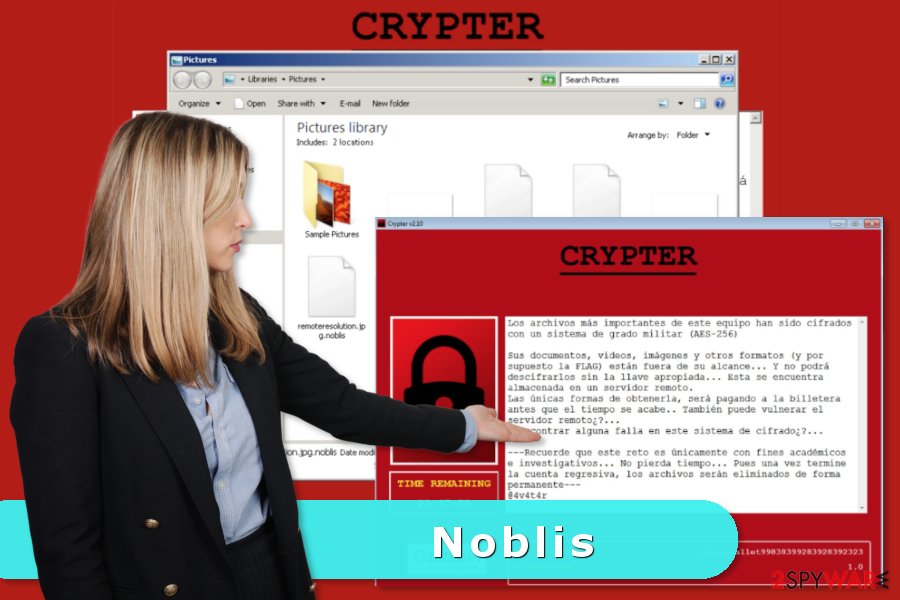
Noblis ransomware is a virus that targets Spanish or English computer users and threatens to delete their files.
Thus, after a ransomware attack, you should clean your computer and restore your files from backups or hope that third-party software will bring back at least some of the most important data. You have to remove Noblis automatically with reputable security software.
In some cases, Noblis ransomware removal might not succeed from the first time due to heavy system modifications made by malware. In such a case, you should access Safe Mode with Networking, as explained below. Once the virus is eliminated, you should take care of not only personal files but also system settings recovery. For that, use Reimage.
Prevention tips that help to minimize the risk of ransomware attack
Noblis is still in development. Thus, you have time to backup your files, obtain antivirus program and learn how to protect yourself from ransomware attack. Unfortunately, any security software cannot fully protect from crypto-malware. Thus, additional actions are needed:
- Be careful with emails. Do not rush to open email attachments or click on provided links without checking information about the sender and making sure that content is safe.
- Download only legitimate software and its updates. Trying to save the money by installing cracked programs is the straightest way to install malware. Additionally, you should not download free programs or updates from unknown file-sharing sites or network.
- Do not accept every offer provided in ads. Pop-ups that offer to download PC scanners, antivirus programs or other application most of the time include malicious content. Keep in mind that malware-laden ads might be displayed on popular websites as well.[3]
- Update software and operating system. Updating software or OS might seem bothersome task. However, it’s one of the most important ways to protect from cyber threats that might exploit outdated program’s vulnerabilities to hack your PC.[4]
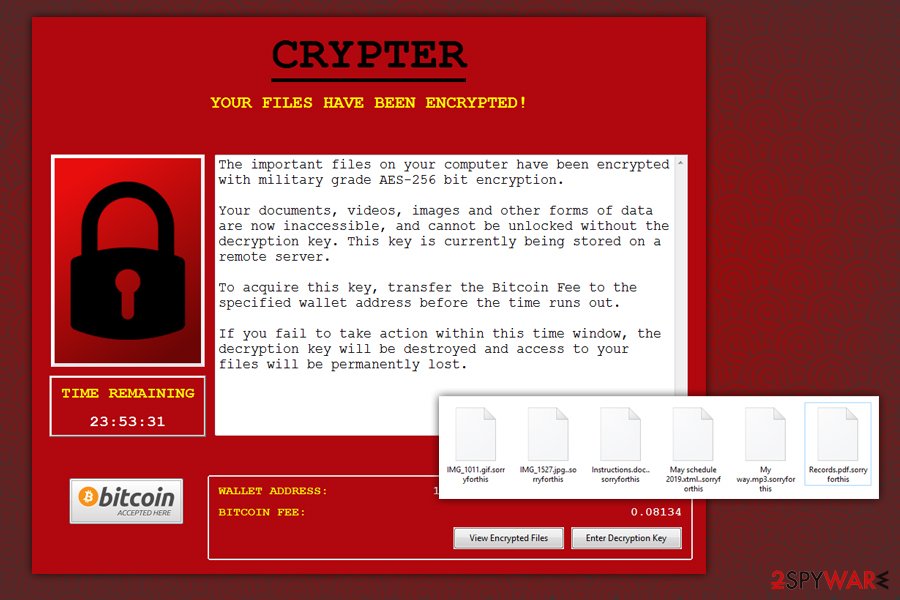
The newest variant of Noblis is sorryforthis – it asks for a 0.08134 BTC ransom and presents a ransom note written in English
Removal of the Noblis virus
Noblis removal has to be completed using reputable malware removal software. The malicious program might inject malicious code into various system processes, and terminating them manually is nearly impossible. Only professional malware removal tools can get rid of them safely.
Before downloading security software, you should reboot your computer to the Safe Mode with Networking. Then you should be able to remove Noblis without any obstacles. Scroll down for more information and detailed removal guidelines.
Finally, to ensure that your system’s operation works just as well (or even better) as previously, you should use PC repair software Reimage. As for personal data recovery, use backups, as it is the only safe method to retrieve files without paying the criminals ransom. If none available, use alternative methods we provide below but keep in mind that chances of success are pretty low.
Remove Noblis using Safe Mode with Networking
To remove ransomware without any problems, you should reboot to Safe Mode with Networking first:
- Windows 7 / Vista / XP
- Click Start → Shutdown → Restart → OK.
- When your computer becomes active, start pressing F8 multiple times until you see the Advanced Boot Options window.
- Select Safe Mode with Networking from the list
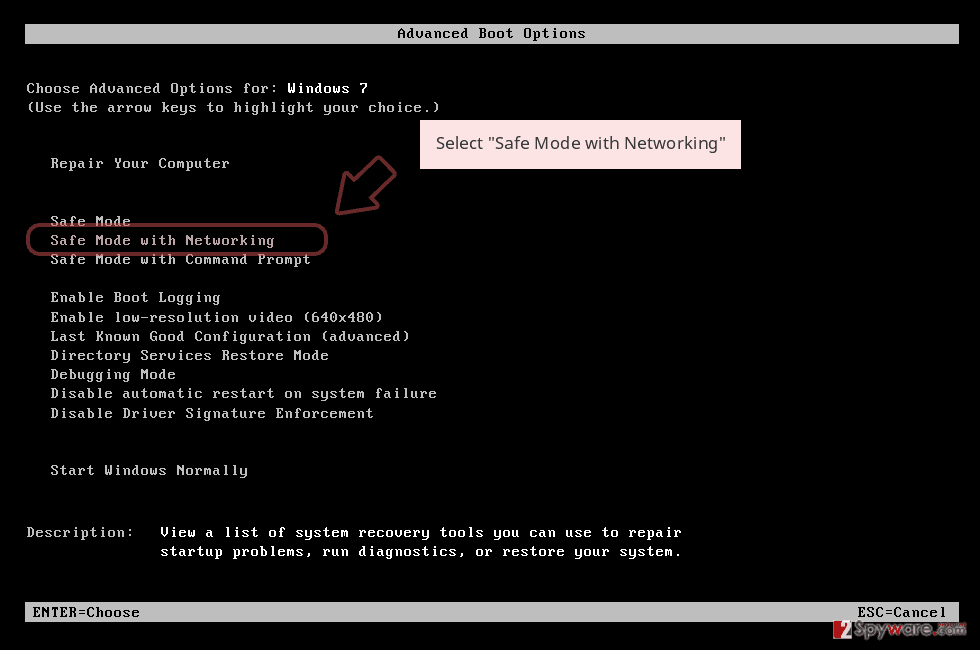
Windows 10 / Windows 8
- Press the Power button at the Windows login screen. Now press and hold Shift, which is on your keyboard, and click Restart..
- Now select Troubleshoot → Advanced options → Startup Settings and finally press Restart.
- Once your computer becomes active, select Enable Safe Mode with Networking in Startup Settings window.
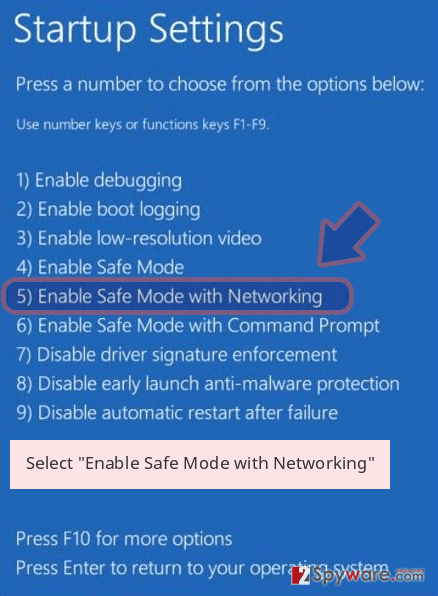
-
Log in to your infected account and start the browser. Download Reimage or other legitimate anti-spyware program. Update it before a full system scan and remove malicious files that belong to your ransomware and complete Noblis removal.
If your ransomware is blocking Safe Mode with Networking, try further method.
Remove Noblis using System Restore
If a previous method did not help, try System Restore:
Bonus: Recover your data
Guide which is presented above is supposed to help you remove Noblis from your computer. To recover your encrypted files, we recommend using a detailed guide prepared by 2-spyware.com security experts.
The official decryptor is not available, but you can try alternative tools to restore your files if you do not have backups:
If your files are encrypted by Noblis, you can use several methods to restore them:
Try Data Recovery Pro
This program is designed to restore files after system wreckage or accidental deletion. However, it is also useful after the ransomware attack.
- Download Data Recovery Pro;
- Follow the steps of Data Recovery Setup and install the program on your computer;
- Launch it and scan your computer for files encrypted by Noblis ransomware;
- Restore them.
Try Windows Previous Versions feature
If System Restore was enabled before the Noblis ransomware attack, follow this guide and restore individual files:
- Find an encrypted file you need to restore and right-click on it;
- Select “Properties” and go to “Previous versions” tab;
- Here, check each of available copies of the file in “Folder versions”. You should select the version you want to recover and click “Restore”.
Try ShadowExplorer
If Shadow Volume Copies were not deleted, Shadow Explorer might be useful in recovery procedure:
- Download Shadow Explorer (http://shadowexplorer.com/);
- Follow a Shadow Explorer Setup Wizard and install this application on your computer;
- Launch the program and go through the drop down menu on the top left corner to select the disk of your encrypted data. Check what folders are there;
- Right-click on the folder you want to restore and select “Export”. You can also select where you want it to be stored.
Noblis decryptor is not released yet.
Finally, you should always think about the protection of crypto-ransomwares. In order to protect your computer from Noblis and other ransomwares, use a reputable anti-spyware, such as Reimage, SpyHunter 5Combo Cleaner or Malwarebytes
This entry was posted on 2019-11-05 at 06:35 and is filed under Ransomware, Viruses.

